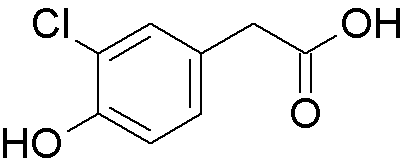3-Chloro-4-hydroxyphenylacetic acid is widely utilized in research focused on:
- Agricultural Chemicals: This compound serves as an important intermediate in the synthesis of herbicides, helping to control unwanted plant growth effectively.
- Pharmaceutical Development: It is explored for its potential anti-inflammatory and analgesic properties, making it a candidate for new pain relief medications.
- Biochemical Research: Researchers use it to study enzyme inhibition and metabolic pathways, aiding in the understanding of various biological processes.
- Polymer Chemistry: The compound can be incorporated into polymer formulations to enhance material properties, such as durability and resistance to degradation.
- Analytical Chemistry: It is utilized as a standard in chromatographic techniques, facilitating the accurate analysis of complex mixtures in various samples.
General Information
Properties
Safety and Regulations
Applications
3-Chloro-4-hydroxyphenylacetic acid is widely utilized in research focused on:
- Agricultural Chemicals: This compound serves as an important intermediate in the synthesis of herbicides, helping to control unwanted plant growth effectively.
- Pharmaceutical Development: It is explored for its potential anti-inflammatory and analgesic properties, making it a candidate for new pain relief medications.
- Biochemical Research: Researchers use it to study enzyme inhibition and metabolic pathways, aiding in the understanding of various biological processes.
- Polymer Chemistry: The compound can be incorporated into polymer formulations to enhance material properties, such as durability and resistance to degradation.
- Analytical Chemistry: It is utilized as a standard in chromatographic techniques, facilitating the accurate analysis of complex mixtures in various samples.
Documents
Safety Data Sheets (SDS)
The SDS provides comprehensive safety information on handling, storage, and disposal of the product.
Product Specification (PS)
The PS provides a comprehensive breakdown of the product’s properties, including chemical composition, physical state, purity, and storage requirements. It also details acceptable quality ranges and the product's intended applications.
Certificates of Analysis (COA)
Search for Certificates of Analysis (COA) by entering the products Lot Number. Lot and Batch Numbers can be found on a product’s label following the words ‘Lot’ or ‘Batch’.
*Catalog Number
*Lot Number
Certificates Of Origin (COO)
This COO confirms the country where the product was manufactured, and also details the materials and components used in it and whether it is derived from natural, synthetic, or other specific sources. This certificate may be required for customs, trade, and regulatory compliance.
*Catalog Number
*Lot Number
Safety Data Sheets (SDS)
The SDS provides comprehensive safety information on handling, storage, and disposal of the product.
DownloadProduct Specification (PS)
The PS provides a comprehensive breakdown of the product’s properties, including chemical composition, physical state, purity, and storage requirements. It also details acceptable quality ranges and the product's intended applications.
DownloadCertificates of Analysis (COA)
Search for Certificates of Analysis (COA) by entering the products Lot Number. Lot and Batch Numbers can be found on a product’s label following the words ‘Lot’ or ‘Batch’.
*Catalog Number
*Lot Number
Certificates Of Origin (COO)
This COO confirms the country where the product was manufactured, and also details the materials and components used in it and whether it is derived from natural, synthetic, or other specific sources. This certificate may be required for customs, trade, and regulatory compliance.

